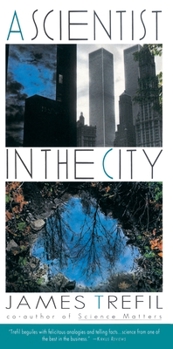A Scientist in the City
Select Format
Select Condition 
Book Overview
A best-selling science writer explores the technology behind the modern city; how it works, what it can tell us about ourselves, and what new developments in science portend for the city of tomorrow. This description may be from another edition of this product.
Format:Paperback
Language:English
ISBN:0385261098
ISBN13:9780385261098
Release Date:December 1994
Publisher:Knopf Doubleday Publishing Group
Length:290 Pages
Weight:0.60 lbs.
Dimensions:0.7" x 5.1" x 8.1"
Customer Reviews
1 rating
Well-written summary of how technology makes cities work
Published by Thriftbooks.com User , 27 years ago
Book Report: A Scientist in the City, by James Trefil I picked up this book because the title intrigued me. I found it a well written and layperson-friendly explanation of the technology that makes cities possible and what that technology is likely to enable in the future. Trefil is an author that one feels a connection with quickly-he is a very beguiling storyteller. This book is not about social issues. It is about the materials and building blocks of cities. Trefil discusses materials, such as wood, brick, concrete, steel and glass. He investigates what holds buildings up and what conspires to tear them down. (The real challenge for a modern skyscraper, for example, is not collapse, but wind.) Moving people, energy and information around are city factors he visits at length. Sound boring? Its not. For example, he discusses how most of the glass manufactured in the U.S. today is made by a process called floating. "Glass is melted, then poured onto a pool of molten tin. The glass floats on the metal, hence the name of the process. Near the furnace, the glass is heated from above to keep it fluid, and as a result it flows into a uniform thin sheet. . . This process has the advantage of never having the glass come into contact with rollers, so that it doesn't have to be ground or polished after it comes out of the furnace." I have no earthly idea what I will ever need that information for, but I find it absolutely fascinating. Cool as that part is, Trefil goes on to discuss the future he believes most likely. He foresees that the Edge City pollution problems can be solved by electric cars and better recycling, but the congestion issues will need the information economy to remove the need to commute at all. New suburbs will stretch farther into the country, enabled by high-speed magnetic levitation trains. (Most people, it develops, adhere to the `Rule of 45'-not commuting longer than 45 minutes.) I find this book thought-provoking, informative, and readable-in-an-airplane. Here are some of excerpts I found interesting: *"The kind of cities we build depend on our understanding of the natural world-what we call science-and on our ability to turn that understanding to our own ends-what we call technology." *"A city is a natural system, and we can study it in the same way we study other natural systems and how they got to be the way they are." He notes that an ecosystem is a place that supports the existence of niches, where energy flows through, where materials tend to move in cycles, and is not static. *"[With respect to plastics] we seem to be filling 10 percent of our dumps with carbon chains taken from deep reservoirs of oil and coal around the world, used briefly, and then reburied." * "I know of no better way to illustrate the essential unity of nature than to note that the amount of traffic the Golden Gate bridge supports and the height reached by the tree outside your window are governe




